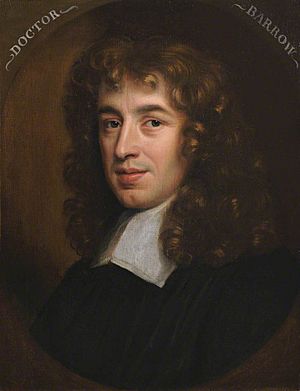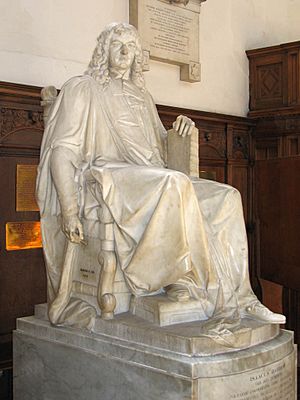Isaac Barrow facts for kids
Quick facts for kids
Isaac Barrow
|
|
|---|---|

Portrait of Barrow by Mary Beale
|
|
| Born | October 1630 London, England
|
| Died | 4 May 1677 (aged 46) London, England
|
| Nationality | English |
| Education | Felsted School, Trinity College, Cambridge |
| Known for | Fundamental theorem of calculus Optics |
| Scientific career | |
| Fields | Mathematics |
| Institutions | Trinity College, Cambridge, Gresham College |
| Academic advisors | James Duport |
| Notable students | Isaac Newton |
| Influences | Gilles Personne de Roberval Vincenzo Viviani |
| Influenced | Isaac Newton |
| Notes | |
|
His mentor was James Duport who was a classicist, but Barrow really learned his mathematics by working under Gilles Personne de Roberval in Paris and Vincenzo Viviani in Florence.
|
|
Isaac Barrow (born October 1630 – died 4 May 1677) was an English church leader and mathematician. He is famous for his important work in developing calculus, a type of advanced math. He is especially known for proving the fundamental theorem of calculus, a key rule in this field.
Barrow also studied the properties of tangents to curves. He was the first to figure out the tangents for a special shape called the kappa curve. He also became the very first Lucasian Professor of Mathematics at Cambridge. This was a very important job, and later, his famous student, Isaac Newton, held the same position.
Contents
Isaac Barrow's Life
Early Years and Schooling
Isaac Barrow was born in London, England. His father, Thomas Barrow, worked as a draper, selling cloth. Isaac was the only child from his father's first marriage to Ann Buggin. Sadly, his mother passed away when Isaac was young.
At first, Isaac went to Charterhouse School. He was known for being quite energetic and sometimes getting into fights there. His father even joked that if God were to take one of his children, Isaac might be the one he could spare most easily! However, Isaac later moved to Felsted School. There, he settled down and learned a lot from his teacher, Martin Holbeach. He studied Greek, Hebrew, Latin, and logic, which prepared him for university.
University Studies
Isaac continued his education at Trinity College, Cambridge. He was a very dedicated student, excelling in both classical studies and mathematics. He earned his first degree in 1648 and became a fellow at the college in 1649. In 1652, he received his master's degree.
However, in 1655, Isaac refused to sign a document supporting the government at the time. Because of this, he received money to travel abroad instead of staying at Cambridge.
Barrow's Travels Abroad
For the next four years, Isaac Barrow traveled through France, Italy, Smyrna, and Constantinople. He had many exciting adventures during this time. One famous story tells how he bravely saved his ship from being captured by pirates.
People described him as being short, thin, and pale. He was also known for his messy clothes and for being a constant smoker. Despite this, he was well-liked by King Charles II and his friends at court. Barrow was known for his clever wit and impressive way of speaking. He lived a very honorable life and was respected by many.
Later Career and Achievements
When the monarchy was brought back to England in 1660, Barrow became a priest. He was also appointed the Regius Professor of Greek at the University of Cambridge. In 1662, he became a professor of geometry at Gresham College.
Then, in 1663, he was chosen as the very first Lucasian Professor at Cambridge. This was a huge honor! While holding this position, he published two important math books, one on geometry and one on optics (the study of light). In 1669, he gave up his professorship to his brilliant student, Isaac Newton.
After this, Barrow spent the rest of his life studying divinity (the study of religion). He became a Doctor of Divinity in 1670. Two years later, in 1672, he became the Master of Trinity College, Cambridge. He helped found the library there and stayed in this role until he passed away.

Barrow's Important Works
Barrow's first major work was an edition of Euclid's Elements, a famous book on geometry. He published it in Latin in 1655 and in English in 1660. He also published another geometry book called Data in 1657.
His lectures from 1664, 1665, and 1666 were published in 1683 as Lectiones Mathematicae. These talks were mostly about the deep ideas behind mathematical truths. His lectures from 1667, published that same year, showed how ancient mathematicians like Archimedes might have found their discoveries.
In 1669, he published his most important math book, Lectiones Opticae et Geometricae. It is believed that Isaac Newton helped review and correct parts of this book. This work was republished in 1674. Barrow also published editions of other famous math books, including works by Apollonius of Perga, Archimedes, and Theodosius of Bithynia.
In his lectures on optics, Barrow explored many problems related to how light reflects and bends. He explained what a "geometrical focus" is and how images are formed. He also made Descartes' explanation of the rainbow much simpler. Barrow was also the first to find the integral of the secant function in a simple, direct way.
Death and Lasting Impact
Isaac Barrow passed away in London at the age of 46. He was never married and was buried in Westminster Abbey, a very famous church.
Besides his math books, Barrow also wrote other important works. His sermons (religious speeches) are considered masterpieces of strong arguments. His book Treatise on the Pope's Supremacy is also seen as a perfect example of a debate. Barrow was known for his great talents and a unique personality.
How Barrow Calculated Tangents
Barrow's geometry lectures included new ways to find the areas and tangents of curves. His method for finding tangents was especially important. It showed how mathematicians like Barrow, Hudde, and Sluze were building on ideas from Fermat. Their work eventually led to the development of differential calculus.
Fermat had noticed that if you knew two points on a curve, you could find the tangent line at one of those points. Barrow expanded on this. He imagined a tiny triangle formed by a point P on the curve and a point Q very, very close to P. He called this the "differential triangle."
By using the coordinates of these two points and ignoring very small numbers, Barrow could find the ratio of the sides of this tiny triangle. This ratio helped him determine the slope of the tangent line. This method was very similar to how differential calculus works today. The main difference is that now we have a general rule to find this ratio, which makes it much faster.
Barrow used this method to find tangents for several complex curves, including the kappa curve and the Folium of Descartes.
See also
 In Spanish: Isaac Barrow para niños
In Spanish: Isaac Barrow para niños
- The lunar crater Barrow on the Moon is named after him.
- Gresham Professors of Geometry


